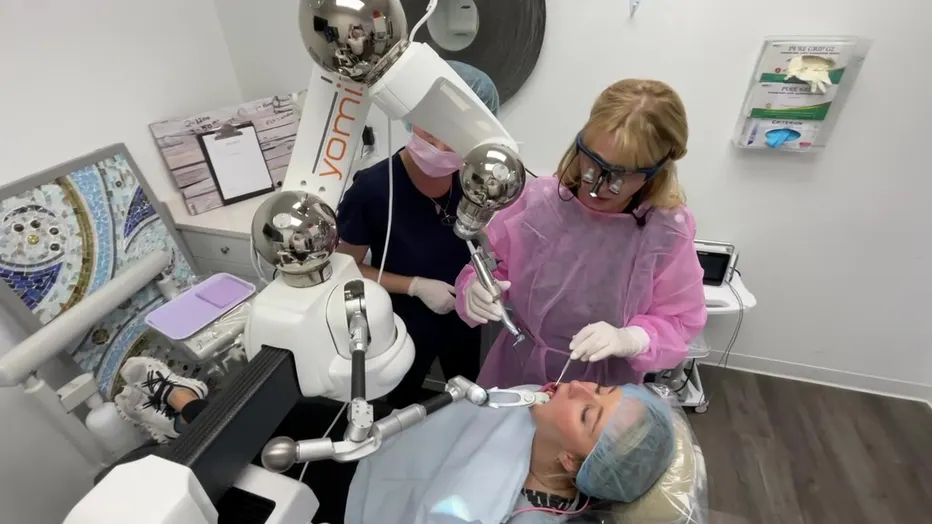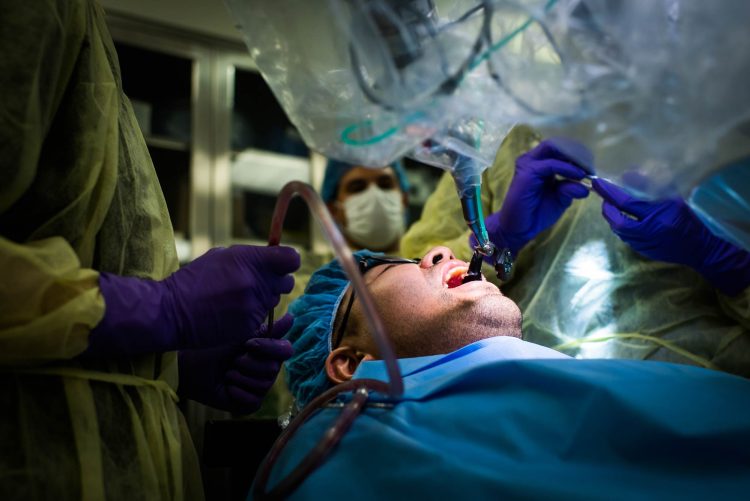In recent years, the world of dentistry has seen incredible advancements, particularly with the integration of technology to enhance treatment outcomes. Among the most exciting developments in this field is the introduction of robotic-assisted dentistry. Robotics in dentistry, although still in its early stages, promises to improve the accuracy, precision, and efficiency of dental procedures. This article will explore the development of robotic technology in dentistry, the benefits it brings to dental care, the challenges of integrating robots into everyday practice, and how robots may shape the future of dentistry.
The Development of Robotic Technology in Dentistry
Robotic technology has been a game-changer in various fields, from manufacturing to healthcare. In dentistry, the idea of using robots for dental procedures may sound like science fiction, but it is rapidly becoming a reality. The introduction of robotics into the dental industry has been driven by the need for more accurate, less invasive treatments and improved patient outcomes.
The first steps in robotic-assisted dentistry can be traced back to the late 20th century when robotic systems were used primarily for dental implant surgeries. The idea behind this technology was to create a more precise method for placing dental implants, ensuring the correct alignment and depth for successful integration with the bone. Early robotic systems focused on guiding the dentist through the procedure, providing real-time data on the exact placement of the implant.
As the technology evolved, robotic systems became more advanced, incorporating features such as 3D imaging, augmented reality, and artificial intelligence (AI) to further enhance precision. Today, some dental robots are fully autonomous, meaning they can perform certain tasks with minimal human intervention. This shift towards autonomy has opened up new possibilities for the future of dentistry, where robots can assist with a range of procedures, from diagnostics to complex surgeries.
Benefits of Robotic Surgery and Precision in Dental Procedures
Robotic-assisted dentistry offers numerous benefits to both patients and dental professionals. Some of the most significant advantages include precision, reduced recovery times, and increased treatment options. Let’s take a closer look at how robotic technology improves dental procedures.
Enhanced Precision and Accuracy
One of the most significant advantages of robotic technology in dentistry is the precision it offers. Traditional dental procedures, especially those involving implants or complex surgeries, require a high level of skill and accuracy. Even experienced dentists can face challenges when it comes to perfect placement and alignment, which can affect the long-term success of the procedure. Robotic systems, however, are capable of achieving unparalleled accuracy.
Robots can perform tasks such as dental implant placement, crown adjustments, and root canal treatments with extreme precision. This is particularly important in procedures where even the slightest mistake can result in complications or the need for additional corrective procedures. For example, robotic systems that assist with dental implants can use 3D imaging to create a virtual map of the patient’s mouth, allowing the robot to place the implant at the exact angle, depth, and location needed for optimal success.
Minimally Invasive Techniques
Robotic systems can perform dental procedures with minimal disruption to surrounding tissues, which is a significant benefit for patients. Traditional dental surgeries often involve cutting through gums and other soft tissues to access the teeth or jawbone. This can lead to longer recovery times, more pain, and a higher risk of infection.
In contrast, robotic-assisted surgeries can be minimally invasive, reducing the need for extensive incisions. For example, in dental implant surgery, robotic systems can make small, precise incisions and guide the placement of the implant with high accuracy, minimizing damage to surrounding tissue. This means less bleeding, a shorter recovery time, and a lower risk of complications.
Faster Treatment Times
Robotic systems can also help speed up dental procedures. While many traditional dental surgeries can take hours to complete, robotic-assisted surgeries can be performed in a fraction of the time. This is particularly beneficial for patients who are anxious about long procedures or for dental practices that want to maximize their efficiency.
Additionally, the use of robots allows for more consistent and predictable outcomes, reducing the likelihood of complications that might require additional follow-up visits. This not only saves time but also helps to reduce the overall cost of treatment for both the patient and the dental office.
Increased Access to Complex Treatments
Robotic technology can also help increase access to complex dental treatments. In remote areas or regions with a shortage of dental specialists, robots can assist general practitioners in performing advanced procedures that they might not have the skills or resources to carry out on their own. By providing guidance, precision, and support, robots can ensure that even complicated dental procedures are performed correctly, regardless of the practitioner’s experience level.
Moreover, robots can help streamline workflow in dental clinics by enabling dental professionals to focus on higher-level tasks while delegating repetitive or complex aspects of the procedure to the robotic system.
Challenges of Integrating Robotics into Everyday Dentistry
While the benefits of robotic-assisted dentistry are undeniable, there are also significant challenges that must be addressed before robots become commonplace in dental offices. These challenges include cost, the need for specialized training, and patient acceptance.
High Initial Costs
The initial cost of purchasing and installing robotic systems in a dental practice can be prohibitively expensive. The equipment itself can cost hundreds of thousands of dollars, and this does not include ongoing maintenance and software updates. For many dental practices, especially smaller ones, this price tag can be a significant barrier to entry.
Additionally, integrating robotic systems into a practice requires significant infrastructure changes, including modifications to the office layout and potentially upgrading existing dental equipment. As a result, many practices are hesitant to invest in robotic technology, especially if they are unsure of the long-term return on investment.

Specialized Training Requirements
Dentists and dental staff must undergo specialized training to operate robotic systems effectively. While robots can assist in performing tasks with high precision, they still require human oversight. Dentists must be well-versed in how the system works and how to troubleshoot any issues that arise during a procedure. This can take time, and dental professionals may need to invest in continuous education to keep up with rapidly evolving technology.
In addition, robotic systems often require a dedicated technician or specialist to operate and maintain them during procedures. This means that dental practices will need to hire or train additional staff, further increasing operational costs.
Patient Acceptance and Comfort
Another challenge that robotic-assisted dentistry faces is patient acceptance. While some patients may be excited about the possibility of receiving high-tech treatment, others may be apprehensive about the idea of robots performing their dental procedures. Patients may feel uncomfortable with the thought of a machine performing tasks that were once handled by a human dentist, leading to potential concerns about safety, effectiveness, and trust.
In order to overcome these concerns, dental practices will need to invest in educating their patients about the benefits of robotic-assisted treatments. Dentists will also need to ensure that they explain the technology in a way that reassures patients that the procedure is safe and that they will still receive personalized care.
Technological Limitations
Despite the incredible potential of robotic technology, there are still limitations that must be addressed. For example, robots are not yet capable of handling every aspect of a dental procedure. While they can perform tasks like implant placement with great precision, they are still unable to replicate the fine motor skills and judgment required for more delicate procedures, such as root canals or restorative treatments.
Additionally, robotic systems are only as good as the data they are given. If the system is fed inaccurate or incomplete data, it may not be able to provide the correct guidance during the procedure. As with all technology, the reliability of robotic systems is dependent on the quality of the software and the information it has access to.
The Future of Robotic-Assisted Dentistry
Despite the challenges, the future of robotic-assisted dentistry looks promising. As technology continues to improve and costs decrease, we can expect more dental practices to adopt robotic systems. The integration of artificial intelligence (AI) into robotic systems will further enhance their ability to assist in complex procedures, making them more adaptable and capable of handling a broader range of tasks.
The future of dentistry may also see more collaboration between human dentists and robots, where robots assist in real-time during procedures while the dentist provides oversight. In this scenario, robots may be used to carry out routine tasks like sterilization, measurements, and monitoring, allowing the dentist to focus on more critical aspects of patient care.
Additionally, robotic systems may become more accessible to patients and dental professionals in the future. With advancements in miniaturization and automation, we may see smaller, more affordable robots that can be used in general dental offices rather than just specialized surgical centers.
Conclusion
The rise of robotic-assisted dentistry marks a transformative moment in the field of dental care. With the ability to perform precise, minimally invasive procedures, robots offer significant benefits to both patients and practitioners. However, integrating robotics into everyday dental practice is not without its challenges. The high costs, specialized training requirements, and patient acceptance issues are obstacles that must be overcome for robotic technology to become commonplace.
Despite these challenges, the future of robotic-assisted dentistry looks bright. As technology continues to evolve, we can expect robots to play an increasingly important role in enhancing the efficiency, accuracy, and accessibility of dental care. With continued advancements in AI and machine learning, robots may one day perform even more complex procedures, helping to create a future where dental care is more effective, personalized, and efficient than ever before.













































Discussion about this post